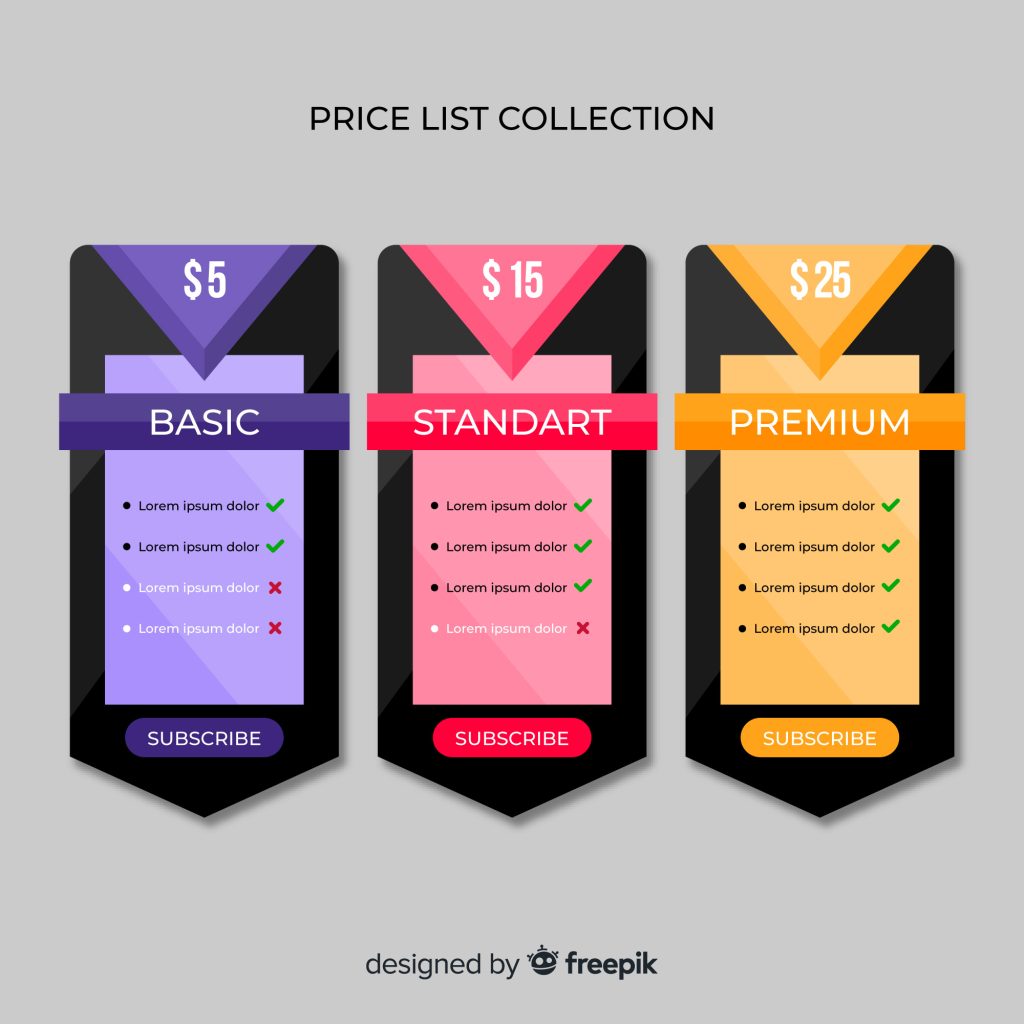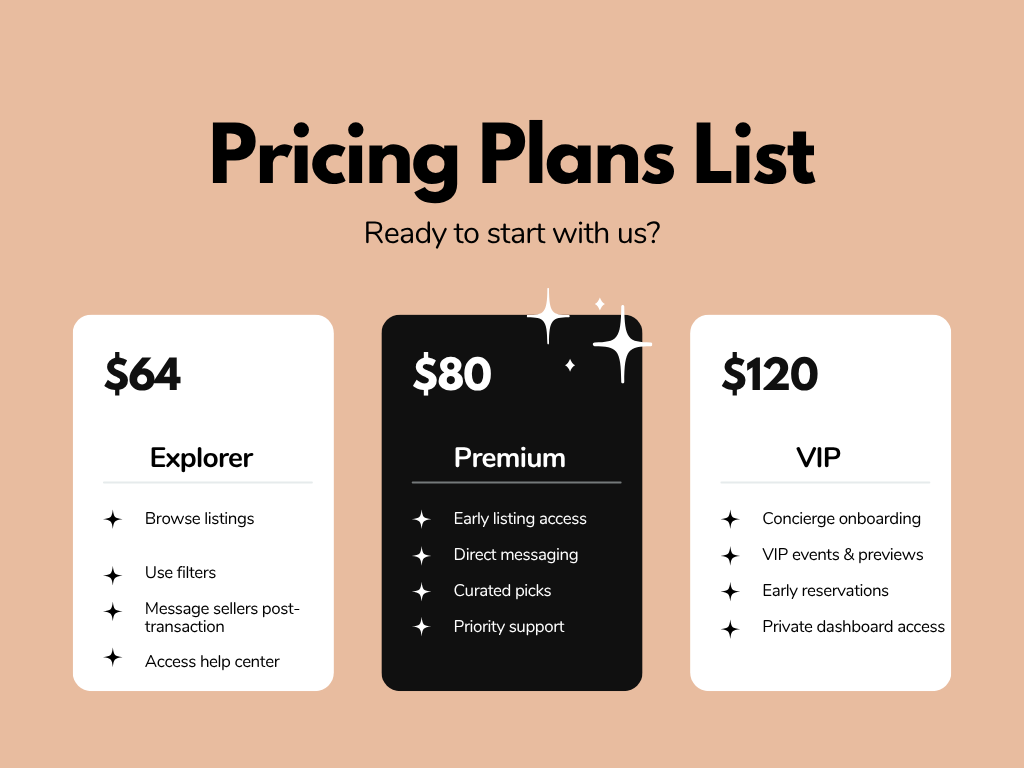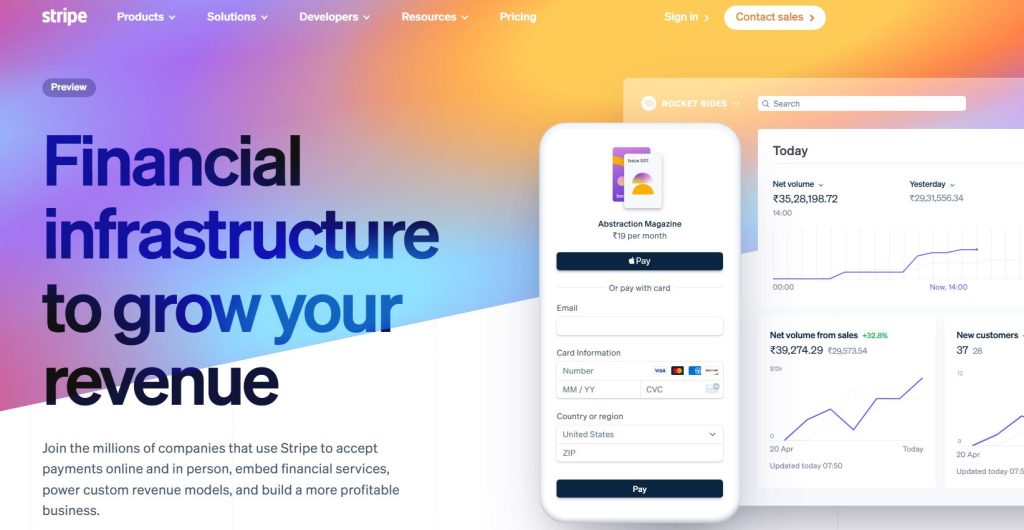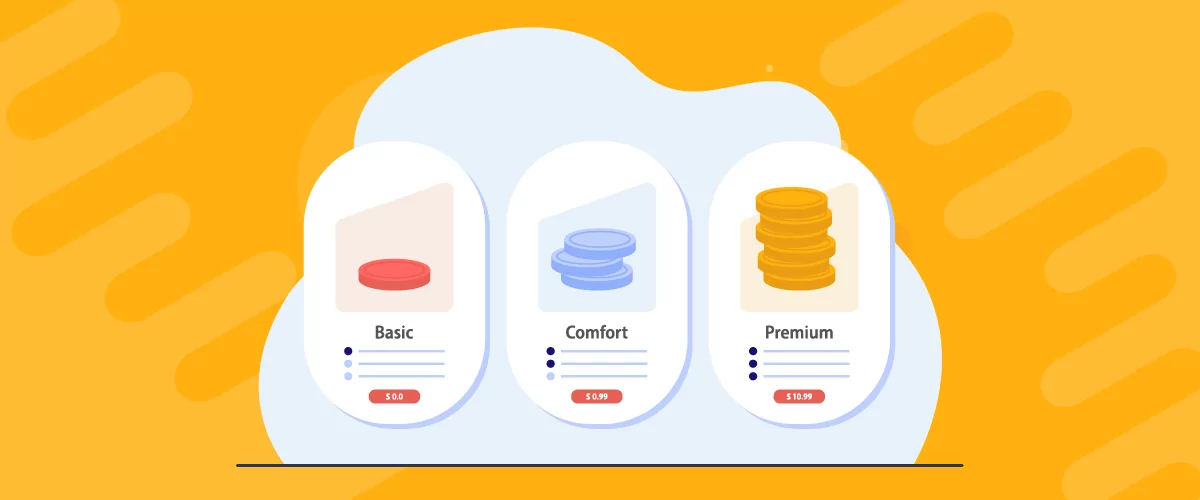Introduction
In today’s increasingly competitive online marketplace landscape, building user loyalty and generating consistent revenue requires more than just transactions. Introducing a tiered membership model in your Sharetribe marketplace can be a powerful strategy to monetize your platform, offer differentiated user experiences, and incentivize engagement from both buyers and sellers.
Whether you’re running a product marketplace, a service platform, or a rental ecosystem, designing a structured membership system can elevate your business to the next level.
What is a Tiered Membership Model?
A tiered membership model divides users into multiple levels or plans—typically free and paid options—each with its own set of features, access levels, and benefits. This structure gives users a choice: stick with a basic free plan or upgrade to premium tiers to unlock more value.
In Sharetribe marketplaces, you can offer different experiences and capabilities for each tier, such as advanced search tools, priority listings, lower commission fees, access to exclusive listings, or direct messaging privileges. These benefits not only increase platform revenue but also foster a sense of community and exclusivity.
Why Use Tiered Memberships in Your Sharetribe Marketplace?
1. Monetization Flexibility
One of the biggest advantages of tiered memberships is the ability to diversify your revenue streams. Sharetribe typically allows you to earn through transaction fees, but that model alone can be limiting—especially in low-volume marketplaces or those with seasonal demand. By introducing subscription-based memberships, you gain predictable monthly income, regardless of whether users are actively transacting. This provides financial stability and enables you to reinvest in platform improvements.
You can offer multiple paid tiers to cater to different budgets, such as a low-cost starter tier and a premium tier with advanced features. Additionally, subscriptions can include value-added services like marketing boosts, analytics dashboards, or priority support, which increase perceived value without proportional increases in cost.
2. User Segmentation
A tiered membership structure helps you segment your user base intelligently, offering tailored experiences that align with different user goals and behaviors. For instance, new or casual users might be happy with a basic free plan, while power users or professionals may require more advanced tools and visibility—making them ideal candidates for premium tiers.

With segmentation, you can also run targeted marketing campaigns, personalize feature rollouts, or test new tools with specific groups. This approach creates a more efficient and user-centric ecosystem, where each member feels the platform understands and caters to their specific needs. Moreover, segmenting by tier can help you understand your community better—what features drive upgrades, where churn happens, and how value is perceived at each level.
3. Exclusivity & Status
Offering exclusive features and benefits to paying members adds an element of prestige and status, which is a powerful motivator in digital communities. Premium members feel valued when they receive early access to listings, featured placement, or badges that denote their commitment and trustworthiness. This kind of exclusivity doesn’t just reward those who pay—it also creates aspirational goals for free users, encouraging them to upgrade.
When done right, this perceived status can lead to a more engaged community, where members actively participate to maintain or elevate their standing. This approach also enhances the overall branding of your marketplace by aligning your most visible users with premium experiences.
4. Growth Incentives
Tiered membership models naturally encourage platform growth by creating incentives for users to upgrade or refer others. As users experience the benefits of higher-tier features—such as increased visibility, advanced analytics, or priority access—they’re more likely to stay active on your platform and invite others to join. You can further support this with gamified rewards, loyalty programs, or referral bonuses tied to membership levels.
Additionally, premium members often generate more content (e.g., listings, reviews, bookings), which enriches the marketplace and attracts even more users. Over time, this creates a self-sustaining cycle: the more valuable the membership benefits, the more users engage and contribute, which increases the overall value of the platform.
Types of Membership Tiers You Can Offer
The success of a tiered membership system depends on aligning benefits with the needs of your users—whether they are sellers trying to grow their business or buyers seeking better deals and access. Below are structured examples of tier types for both seller and buyer audiences, each crafted to create a sense of progression, value, and exclusivity.

For Sellers
1. Basic Tier (Free Plan)
Perfect for new or occasional sellers who want to test the platform before committing. This tier offers the essentials:
Limited number of active listings (e.g., 3–5 at a time)
Standard placement in search results (no prioritization)
Access to basic profile features
Email-only support
Limited access to insights (e.g., views per listing only)
This level encourages exploration while creating a clear incentive to upgrade once sellers grow or hit listing limits.
2. Pro Tier
Designed for semi-professional sellers or small businesses who want better visibility and tools to scale.
Increased listing capacity (e.g., up to 20 listings)
Featured placement in search results and homepage sections
Access to a performance dashboard showing views, clicks, conversion rates
Option to add video to listings
Priority email and live chat support
Access to promotional campaigns (e.g., email newsletter inclusion)
This tier strikes a balance between affordability and functionality, ideal for serious sellers aiming to grow their presence.
3. Elite Tier
A premium-level plan tailored for top sellers or enterprise partners who demand full control and optimization.
Unlimited listings and bulk listing management tools
Advanced performance analytics with trend breakdowns and user behavior insights
Promotional tools like discount codes, retargeting pixel support, and homepage banners
“Verified Seller” or “Trusted Partner” badge for increased credibility
Early or beta access to new platform features
Dedicated account manager or concierge support
Monthly performance reviews or strategy calls (optional add-on)
This tier is positioned as a growth partner, offering sellers high-level visibility and strategic tools to dominate their niche.

For Buyers
1. Explorer Tier (Free Plan)
Ideal for first-time or casual users who want to browse and make simple purchases or bookings.
Access to all publicly available listings
Standard search filters and sorting
Ability to message sellers only after initiating a transaction
Access to support knowledge base and email inquiries
This tier is useful to build trust and introduce the platform to newcomers without overwhelming them.
2. Premium Buyer Tier
Crafted for active buyers who value early access and smoother communication.
Early access to new listings before they go public (e.g., 24–48 hours in advance)
Ability to message sellers directly before purchase
Access to curated collections based on buyer preferences
Save favorite searches and get instant notifications
Priority support response time
This tier helps buyers make faster, more informed decisions—especially useful in fast-moving marketplaces like real estate, rentals, or limited-edition goods.
3. VIP Buyer Tier
A top-tier offering for high-value clients who want personalized service and exclusive access.
Personalized onboarding and concierge shopping support
Invitations to members-only events, product previews, or virtual tours
Exclusive deals, early-bird discounts, or loyalty perks
Ability to reserve items in advance or request custom listings
White-glove customer support via phone, WhatsApp, or live chat
Access to a private buyer dashboard or assistant
This level cultivates loyalty by offering an elite, high-touch experience that turns occasional buyers into long-term brand advocates.
How to Implement Membership Tiers in Sharetribe?
While Sharetribe doesn’t offer built-in support for tiered memberships in its default configuration, its flexible architecture and developer-friendly APIs make it entirely possible to build a powerful membership model. With the right blend of backend logic, UI personalization, and third-party integrations, you can offer a highly customized experience for different user tiers. Here’s how to do it effectively:
1. Stripe Integration for Subscriptions
The foundation of any paid membership model lies in a reliable subscription billing system—and Stripe is the go-to tool for this. By integrating Stripe’s subscription API with your Sharetribe marketplace, you can offer users multiple plans (monthly, quarterly, or annual), each tied to a different membership tier (e.g., Basic, Pro, VIP).
For example, when a seller chooses the “Pro Seller Plan” at $29/month, Stripe handles the recurring billing and returns a subscription status to your backend. Based on that, your application can unlock specific features, such as increased listing limits or access to advanced analytics.

You can also implement webhooks that notify your marketplace when a subscription is canceled, downgraded, or failed—so that access can be automatically adjusted without manual intervention. Stripe’s customer portal can be embedded for self-service upgrades and billing management, reducing support overhead.
2. Custom Listing Visibility
A critical aspect of delivering value to premium users is prioritizing their visibility across the platform. Sharetribe’s codebase allows you to customize the way listings are displayed and sorted, especially if you’re using a self-hosted version of Sharetribe (like Sharetribe Web Template or a headless frontend via Sharetribe Webhooks and APIs).

You can implement logic that elevates listings from premium members in search results, homepage carousels, or featured sections. For instance:
Only Elite-tier sellers appear in a “Verified Top Sellers” carousel.
Premium listings are displayed at the top of search results using a custom sort algorithm.
Exclusive listings visible only to VIP-tier buyers.
You can also add visual tags like “Premium Listing”, special color badges, or border highlights to differentiate and elevate these listings within the UI, enhancing their discoverability and conversion rate.
3. Access-Based Features
Once users are subscribed to a tier, your frontend can dynamically show or hide features based on their membership level. This is crucial for creating a differentiated user experience. Access control can be implemented using conditionals in your React components (if using Sharetribe Web Template), where features are displayed only if the user meets certain criteria.

Examples include:
Advanced Filters: Pro buyers can access advanced search filters (e.g., sort by rating, filter by verified sellers).
Downloadable Resources: Allow only premium users to download manuals, guides, or templates tied to a listing.
Direct Messaging: Limit real-time messaging or video chat scheduling to VIP buyers.
Listing Scheduler: Enable calendar-based scheduling of listings only for paid sellers (e.g., for rental or service platforms).
4. API-Based Tier Management
Sharetribe’s APIs provide flexible ways to store and retrieve custom user data, allowing you to associate membership information with user profiles or transactions. You can store a user’s membership tier as an extended data field (e.g., publicData.membershipLevel) and use this metadata throughout your application.

Here’s how it might work:
When a user subscribes via Stripe, a webhook updates their
publicData.membershipLevelto “Pro”.On the frontend, you retrieve this value and render premium-only UI components if the level matches.
In the backend, you can restrict or validate listing creation, messaging, or other workflows based on the same value.
For instance, if you’re building a coaching marketplace, only “Gold” tier users might be allowed to create group sessions, while “Silver” can only offer 1-on-1 sessions.
With this system in place, the membership logic becomes highly maintainable, scalable, and responsive to real-time changes—perfect for high-growth marketplaces.
Ideas for Premium Features to Offer
To drive upgrades and justify recurring fees, your premium membership tiers must deliver clear, tangible value. These features not only create differentiation between free and paid users but also help users achieve more success on your platform—whether it’s better visibility, increased sales, or exclusive access. Below are some high-impact premium feature ideas to consider implementing in your Sharetribe marketplace:
1. Priority Placement in Search Results
One of the most compelling perks for sellers is increased visibility—often translating directly to higher engagement and more sales. Offering priority placement means that listings from premium or verified sellers appear higher in search results, are pinned to the top of category pages, or are highlighted in exclusive sections such as “Top Picks,” “Verified Professionals,” or “Featured Listings.” This not only boosts their chances of being discovered but also enhances their perceived credibility in the eyes of potential buyers.
In marketplaces where competition is high, even a slight edge in visibility can make a significant difference in conversions. By positioning premium listings more prominently, you create a tangible incentive for sellers to upgrade to paid tiers.
Additionally, you can support this feature with visual cues—like premium badges, border highlights, or trust indicators—which reinforce their elevated status. You can also integrate analytics to show premium sellers their increased visibility metrics (e.g., impressions, click-through rates), helping them see the ROI of their subscription.
2. Reduced Transaction Fees
Sellers are naturally drawn to pricing structures that reward their growth and loyalty. Offering reduced transaction or commission fees to premium-tier members is a powerful way to incentivize upgrades and long-term engagement. For instance, basic users might pay a 10% fee per sale, while Pro or Elite members enjoy a reduced rate of 5% or even lower based on volume.
For high-volume sellers, this difference translates into significant savings, making a subscription plan feel like an investment rather than an expense.
This pricing strategy also encourages sellers to list more frequently and scale their operations within your platform, knowing they’ll retain a larger portion of their revenue. Additionally, lower fees can reduce the temptation for sellers to move transactions off-platform—a common challenge in online marketplaces. You can further enhance this benefit by offering flexible fee structures, such as tiered discounts based on monthly sales volume or fixed monthly plans with zero commissions.
3. Analytics Dashboard for Sellers
In today’s competitive digital economy, data is a powerful asset—especially for marketplace sellers who rely on performance visibility to grow their business. Offering a dedicated analytics dashboard as a premium feature gives sellers the actionable insights they need to make smarter decisions. This dashboard can display essential metrics such as listing views, click-through rates, conversion rates, booking trends, seasonal demand patterns, top-selling products, and customer demographics.
For professional sellers, these insights are invaluable. They can identify which listings need optimization, adjust pricing strategies, and understand what buyers are searching for most frequently. By analyzing buyer behavior—such as time spent on listings or abandonment points—sellers can enhance their product descriptions, improve photos, and refine availability windows to better meet demand.

4. Exclusive Access to Buyer or Seller Groups
Beyond features and discounts, what truly keeps users engaged is a sense of belonging and connection. Offering exclusive access to curated buyer or seller groups adds community value to your premium plans. These private spaces—such as members-only forums, early-access buyer clubs, or verified vendor networks—can serve as hubs for engagement, collaboration, and insider opportunities.
For example, Pro-tier buyers might gain entry to an “Early Access Club,” where they can browse and book new listings 24–48 hours before the general public. This creates a VIP-like experience and incentivizes serious buyers to upgrade. On the seller side, Elite-tier vendors could be invited to a “Verified Vendor Network,” where they receive premium client leads, exclusive partnership offers, and access to workshops or webinars hosted by industry experts.
5. Ability to Schedule Listings or Services in Advance
Time-saving automation is a key value driver for serious marketplace users, especially those managing multiple offerings. Giving premium members the ability to schedule listings or services in advance adds significant convenience and operational efficiency. This feature allows sellers or service providers to pre-set the exact date and time when listings go live, expire, or rotate—perfect for managing seasonal inventory, promotional campaigns, or service availability.
For example, a rental host with properties in different locations could schedule listings to go live just before peak travel dates, while a service provider could plan weekly or monthly time slots without logging in daily. Similarly, businesses launching time-sensitive promotions can prepare their listings in advance and go live automatically, reducing manual effort and improving timing precision.

6. Discounted or Priority Access to Marketplace Events
Creating a premium experience goes beyond digital perks—exclusive access to events and promotions can significantly elevate the value of a membership. If your marketplace hosts seasonal campaigns, product showcases, virtual webinars, or offline meetups, offering priority or discounted access to premium users adds a tangible VIP benefit that fosters loyalty and engagement.
For example, premium sellers might receive early invitations to participate in high-traffic seasonal sales, giving them a head start in capturing customer attention. Likewise, top-tier buyers could be granted early access to new product launches, limited-edition items, or curated collections. You might also reserve premium-only slots for exclusive networking events, training sessions, or partner spotlights.
7. Verified Badge or Premium Profile Layout
In a marketplace environment where trust is everything, visual credibility signals play a crucial role in influencing buyer behavior. Offering premium members a “Verified” badge, enhanced profile styling, or animated listing highlights gives them a clear advantage in standing out and building trust at a glance.
These visual markers—such as a verified checkmark, premium border color, gold star icon, or even a richer profile layout—immediately communicate professionalism, legitimacy, and platform endorsement. This not only reassures buyers but also boosts engagement and conversion rates, especially in marketplaces where users rely heavily on reputation and appearance when making decisions.
Best Practices for a Successful Membership Model
Designing a tiered membership model is as much about psychology and value delivery as it is about pricing. The most successful models evolve over time through testing, user feedback, and analytics. Here are proven best practices to follow when implementing memberships in your Sharetribe marketplace:
Start Simple
Avoid overwhelming users with too many options from the start. Instead, begin with two core tiers—a free plan and a premium plan—and observe how users respond. This allows you to test core assumptions, measure upgrade conversion rates, and collect feedback before scaling up to more complex structures like three or four tiers.
Make the Value Clear
Your premium benefits should be visibly and clearly communicated. Use intuitive comparison tables, hover tooltips, and in-context prompts (e.g., “Upgrade to unlock this feature”) to show users what they’re missing. Avoid vague language—be explicit about how a feature will improve their experience or results. Visual aids like icons, checklists, or badges can make this even more compelling.
Provide Trial Access
Offer free trials or temporary access to premium features so users can experience the value firsthand without risk. For example, give new users a 7-day Pro trial with full access to analytics, advanced filters, or listing boosts. After experiencing the benefits, they’re more likely to convert to a paid tier, especially if you follow up with well-timed upgrade prompts or limited-time discounts.
Reward Loyalty
Encourage long-term platform use by rewarding activity or referrals with tier upgrades or discounts. For example, sellers who complete 10 transactions or invite five new users could unlock Pro status for a month. This gamification not only increases engagement but also reduces churn and makes users feel appreciated.
A/B Test Pricing
No membership model is perfect from the beginning. Run A/B tests to explore different pricing levels, billing intervals (monthly vs. annual), and feature combinations. You might find that certain segments respond better to mid-tier pricing, while others prefer high-ticket plans with more exclusivity. Testing allows you to optimize revenue without alienating budget-conscious users.
Conclusion
Implementing a tiered membership model in your Sharetribe marketplace is more than just a monetization strategy—it’s a powerful tool for growth, personalization, and long-term user engagement. By offering premium features like priority listings, reduced fees, analytics tools, and exclusive access, you give your users real, tangible value that aligns with their goals—whether they’re buyers looking for the best deals or sellers aiming to scale their business.
Though Sharetribe doesn’t offer out-of-the-box tiered memberships, its flexibility and developer-friendly architecture make it fully possible through smart use of Stripe integration, custom feature gating, and API-based logic. Starting simple, testing frequently, and communicating value clearly will help you build a membership system that not only increases revenue but also fosters user loyalty and satisfaction.
FAQ's
1. Can I implement tiered memberships in Sharetribe without coding?
Not entirely. While Sharetribe allows some level of customization through its admin console, implementing full tiered membership functionality—like gated features, subscription billing, and dynamic user access—typically requires custom development using Sharetribe’s APIs and external tools like Stripe. However, once set up, the process can be automated and managed efficiently.
2. How do I manage recurring payments for memberships?
You can use Stripe Subscriptions to manage recurring billing. Stripe allows you to create multiple pricing plans, handle upgrades/downgrades, and receive webhook notifications when a user’s subscription status changes. These updates can then be used to control access to premium features in your Sharetribe marketplace.
3. Will free users still have access to core marketplace features?
Yes, and they should. Your free plan should provide enough value to encourage adoption and usage, such as browsing listings, basic search, or creating a limited number of listings. The goal is to create a clear incentive for users to upgrade—without completely restricting the platform’s functionality for free users.
4. Can I offer different memberships for buyers and sellers?
Absolutely. You can build separate tier systems for buyers and sellers, each with tailored benefits. For example, buyers can get early access to listings or exclusive discounts, while sellers may receive priority placement, analytics, or promotional tools. The backend logic can differentiate between user roles and apply the appropriate access controls.
5. What happens when a user’s membership expires or fails to renew?
When a subscription fails or is canceled, Stripe can trigger a webhook to your backend, allowing you to automatically downgrade the user’s tier or restrict access to premium features. You can also notify the user with reminders or offer a grace period to renew before losing access.






